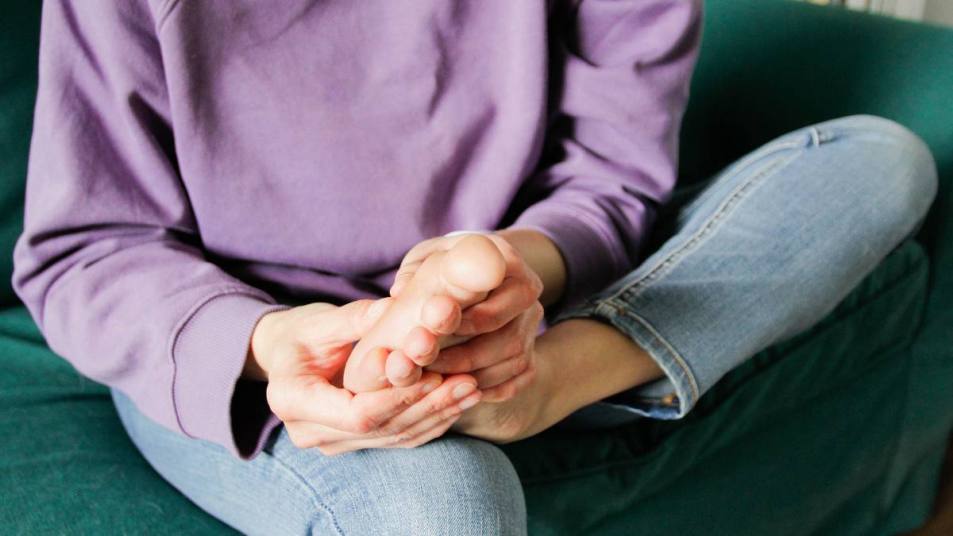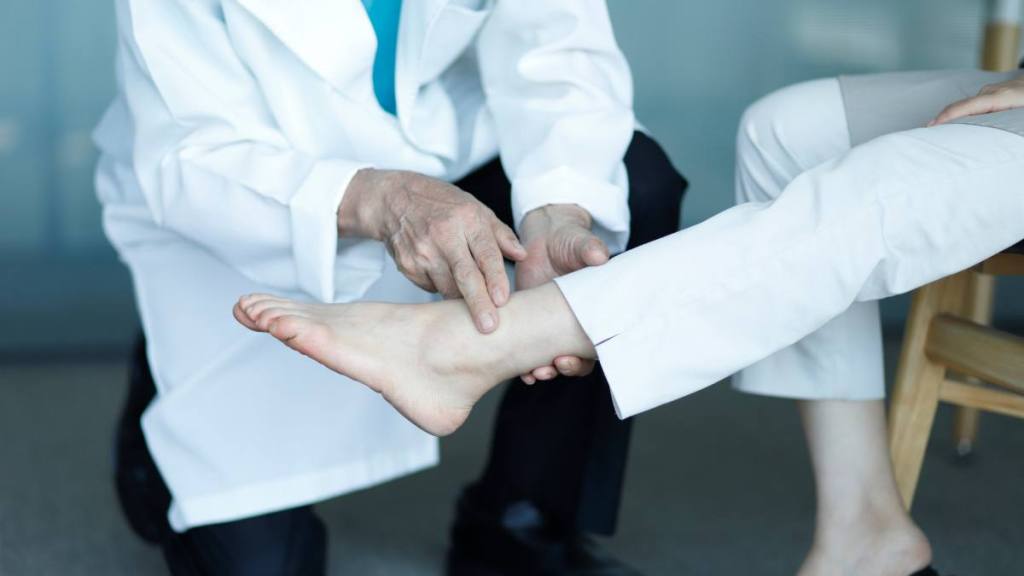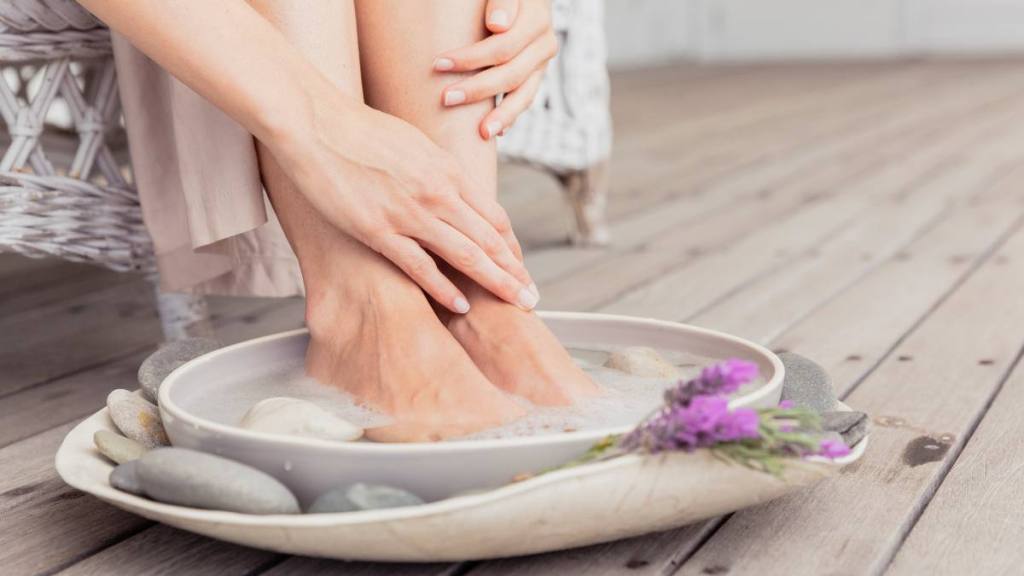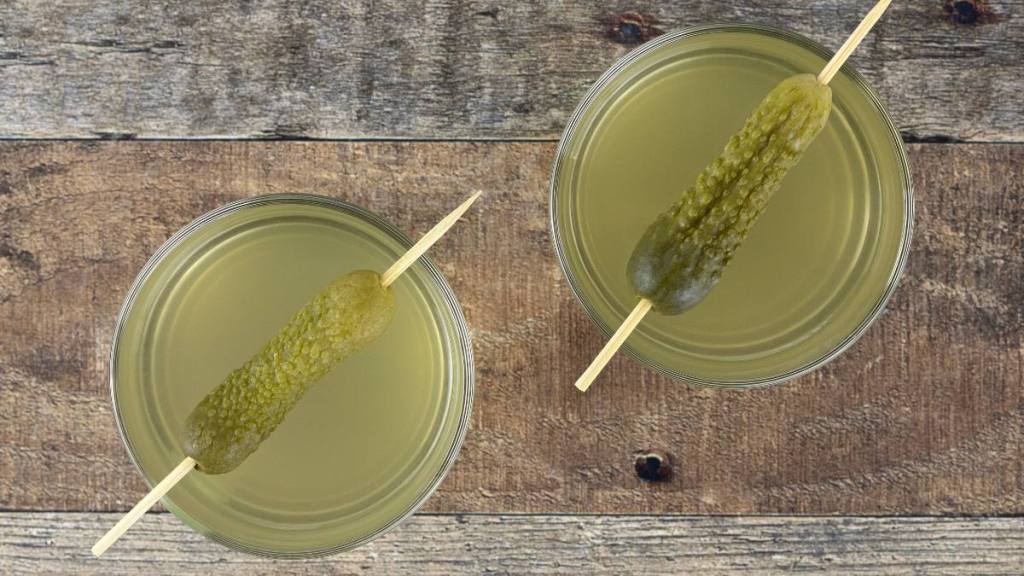Foot Doctors Share 6 Ways to Ease Toe Cramps & What It Means When the Pain Strikes After Exercise
Plus, the sip athletes swear by to calm a cramp

You probably don’t spend much time thinking about your toes, unless you’re trimming your nails or getting a pedicure. That’s understandable, but our toes play a crucial role in movement, contributing to posture, balance and gait. These responsibilities often go unnoticed until something goes wrong — like toe cramps. If you’ve ever had them, you know how crippling toe cramps can be. Here, we take a closer look at their causes and provide simple tips for managing them at home.
What are toe cramps?
Toe cramps are one of the most common foot-related complaints. They occur when the muscles in and around the foot and the associated tendons involuntarily contract but don’t immediately relax, explains Kelly John, DPM, MHA, FACFAS, DABPM, a board-certified podiatrist and surgeon and assistant professor at Des Moines University’s College of Podiatric Medicine and Surgery.
These cramps are very similar “to how you would get a charley horse in your thigh or a cramp in your stomach,” adds Adam Bitterman, DO, a board-certified orthopedic surgeon and the chair of orthopedic surgery at Northwell Huntington Hospital in Huntington, New York. “They typically aren’t serious, but they can be quite painful.”
Common causes of toe cramps
The experts we interviewed said toe cramps can occur for various reasons, including:
- Dehydration
- Nutritional deficiencies
- Medical conditions that cause cramping (e.g., arthritis, Parkinson’s disease and multiple sclerosis)
- Wearing certain types of shoes, like high heels and tight-fitting dress shoes
- Vascular issues (e.g., poor blood flow)
- Muscle overuse
- Pregnancy
Sometimes, toe cramps occur because of inactivity. For example, Dr. John says that if you don’t regularly use the muscles in your feet and then suddenly increase your activity level, cramping might occur. Similarly, if you exercise regularly but don’t cool down afterward, your muscles are more likely to tense up (more on that below).
When to see a doctor about toe cramps

Almost everyone experiences toe cramps at one time or another. Each foot has 29 muscles, and like other muscles, they sometimes tense up and spasm. Still, it’s important to listen to your body.
“Once cramping limits your activity or occurs daily or even weekly, it’s worthwhile to ask your physician about it because it could be due to an underlying factor that might be more serious,” says Daniel Stewart, DPM, an assistant professor at Barry University Foot & Ankle Institute in Miami, Florida. “The sooner a doctor can respond to your symptoms, the better.”
Dr. Bitterman echoes this advice. “You should see a medical professional if you have unrelenting toe cramps or more mild cramps that last for two weeks or longer.” Even if your symptoms are caused by something minor like dehydration or a nutritional deficiency, it’s better to be safe than sorry.
6 doctor-recommended tips for toe cramp relief
Even though toe cramps affect everyone differently, you can do plenty to ease muscle tension, relieve pain, and promote mobility. Here are 6 doctor-recommended tips:
1. Stay active
If you regularly experience toe cramps, you might think the best medicine is rest, but that’s the opposite of what experts suggest. Though it might sound counterintuitive, Dr. Stewart says the best remedy for toe cramps is strengthening the small muscles in your feet with exercise. For example, regular walks can help build up the muscles in your feet responsible for support and balance. Here, three simple exercises that can help:
Doming
If walking isn’t an option due to low mobility or other health problems, Dr. Stewart recommends foot doming, an easy exercise practiced by many runners and athletes. Here’s how to do it:
Step 1: Sit down, take off your shoes and socks and put your feet flat on the floor.
Step 2: Now, try to “shorten” your foot. To do that, press the tips of your toes into the floor and create a dome with your sole like you’re trying to pick something up. While doming your foot, keep your toes as straight as possible. Hold this position for a few seconds and then relax. Repeat several times on each foot.
This video provides step-by-step foot doming instructions:
Dr. Bitterman recommends several other strengthening exercises, including:
Circumduction
This exercise increases the range of motion in your ankle muscles. It’s often recommended for ankle sprains and other similar injuries but can benefit your other foot muscles as well. Specifically, it supports mobility and increases blood flow to your feet. This video explains how to do it:
Toe curls
For this exercise, sit down with your feet flat on the floor. Next, curl all of the toes on both feet and hold the position for 10 seconds. At the end of that period, straighten your toes and take a few-second break, then repeat. Dr. Bitterman recommends doing this exercise 5-10 times daily. Many people find it reduces cramps and increases muscle strength.
2. Wear the right shoes
Dr. Stewart says wearing restrictive shoes is one of the most common causes of toe cramps. That’s because certain types of footwear, like “high heels and tight dress shoes, overstress the small muscles in the foot.”
The solution? Wearing “shoes with wide toe boxes and supportive arch control,” he explains. “This can help minimize toe cramps because [shoes with these designs are] better structured to support the feet and toes.”
Dr. Stewart recommends brands like Brooks, New Balance and Hokas. He says shoes from these manufacturers typically feature wider toe boxes and are designed to support the foot’s structure.
If you don’t want to give up high heels and pumps, that’s okay! But you must be mindful of their design. “Finding a heeled shoe where the shoe is held to your foot — like a boot or an ankle strap sandal, rather than a pump or heel with a minimal toe strap — can ease the requirements of your foot muscles because they don’t have to work so hard to keep the shoe in place,” Dr. John says. Likewise, “changing up heel height day to day or throughout the day can be beneficial.” In other words, try wearing flats one day and heels the next. A regular shoe rotation can limit stress on your toe muscles and prevent them from seizing up.
Related: Foot Pain is the Menopause Symptom No One Warned You About: How to Relieve It
3. Relax muscle tension with a warm soak

You know that a warm compress can relieve sore muscles and mobilize stiff joints, but it can be just as beneficial for toe cramps. In fact, applying a heating pad or a hot water bottle to your toe muscles increases blood flow to your feet and reduces pain and swelling.
Scientific studies confirm these benefits. One, published in the journal Life, concluded that localized heat therapy provided pain relief, improved muscular strength and flexibility and facilitated a return to normal function. Although these findings were assessed on lower back pain, it’s safe to assume the same benefits can be applied to the feet.
You can take these benefits even further by soaking your feet in warm water and Epsom salts. Epsom salt soaks are one of the first lines of defense for tense muscles.
Related: 10 Brilliant Uses for Epsom Salt
4. Live a heart-healthy lifestyle
According to Dr. Stewart, “toe cramping that occurs after exercise can be a telltale sign of lack of blood flow.” About 12% of American adults experience claudication (or pain and cramping) caused by arterial blockages in the legs and feet. That number increases to 20% of people age 70 and older.
Even so, you don’t have to suffer. In most cases, “maintaining appropriate cardiovascular health prevents this kind of toe cramping,” he says. Everyone’s needs vary, but as a general rule of thumb, the experts we interviewed recommend exercising at least 30 minutes daily; eating a balanced diet containing fruits, vegetables and whole grains; avoiding excess salt and saturated fats; and quitting smoking. Small lifestyle changes like these can support healthy circulation, ensuring the muscles in your feet get the oxygen and nutrients needed to thrive.
Related: Drinking This Veggie Juice Can Improve Your Workouts and Ward Off Muscle Cramps
5. Stretch before and after exercise
Remember how we said exercise is good for your foot muscles? That’s true, but for optimal results, be sure to stretch before and after your workout. Stretching reduces your risk of potential injury, but it also promotes healthy blood flow, which is key for cramp prevention.
“You want to stretch everything from your hamstrings and quads, all the way down to your pelvis and toes,” Dr. Bitterman says. “This will help improve your flexibility, your mechanics and, ultimately, your circulation.”
Dr. Bitterman knows what he’s talking about. A study published in the journal Physiology found that participants who did passive leg stretches five times a week for three months had increased blood flow in their lower legs. Stretching also seemed to dilate blood vessels, making it easier for blood to travel to and from the heart. These findings led researchers to conclude that stretching could be an effective, non-drug treatment for improving blood vessel health. And when your blood vessels are healthy, your muscles are less likely to cramp up.
Related: 5 Stretches You Can Do In Bed to Melt Away Neck and Shoulder Pain
6. Stay hydrated
Proper hydration benefits your entire body, but it’s particularly helpful in terms of cramp prevention. That’s because drinking water and other beverages helps keep electrolyte levels in check. Electrolytes, like sodium, potassium and magnesium, transmit signals between nerve cells, allowing your muscles to relax and contract. But if they fall below normal levels, your muscles are more likely to spasm and cramp.
Good old-fashioned tap water is an effective way to combat these issues, but if you want to ease toe cramps quickly, there are other options. For example, drinks like Pedialyte and Gatorade contain more electrolytes than water alone. You might also benefit from drinking pickle juice. Yes — pickle juice!

“Pickle juice is a favorite amongst athletes,” Dr. John says. “Although the exact mechanism is unknown, some studies show a greater reduction of cramps with pickle juice over a placebo.” Not a fan of pickles? He notes that there are also commercial over-the-counter products that are marketed for leg cramp relief.
One to try: KRAMPADE 2K Original. “This stuff works better than any other electrolyte supplement,” raves verified buyer Matt Polus. “Simply the best I’ve found and the only thing that works for my cramping.”
Something to keep in mind: If you plan on trying an electrolyte supplement, Dr. John encourages you to speak with your doctor first. Although rare, “a sudden shift in electrolytes can cause cardiac arrhythmias (irregular heartbeat),” she explains.
Related: How An Electrolyte Water Like Liquid IV Can Help You Lose Weight and Have More Energy
The bottom line: listen to your feet
Toe cramps can be painful and annoying, but you shouldn’t ignore them. “It may seem odd, but your feet are frequently the ‘first sign’ of many underlying conditions, especially related to vascular, neurological, and nutritional issues,” Dr. Stewart says. “So, check in with your doctor if toe cramping is happening to you!”
This content is not a substitute for professional medical advice or diagnosis. Always consult your physician before pursuing any treatment plan.













